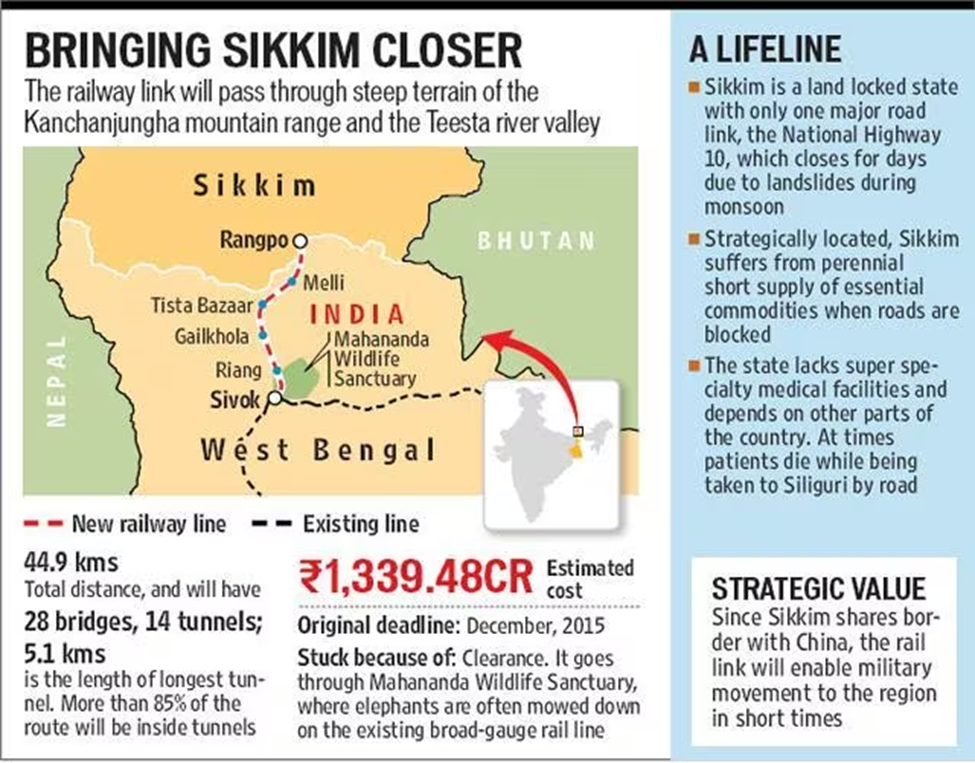Sikkim Chief Minister Prem Singh Tamang on Wednesday announced that the long-pending railway project connecting Siliguri in West Bengal to Sikkim is now expected to be completed by 2027, marking a major step forward in the Himalayan state’s connectivity and infrastructure aspirations.
The Chief Minister made the declaration while addressing the concluding ceremony of the Discover Rabong Cho-Dzo Fest 2025, asserting that the anticipated rail link would “bolster tourism” and “provide seamless connectivity” to a region long hindered by limited access.
“The project will ease travel into the hill state and play a pivotal role in its economic upliftment,” Tamang said.
Sanctioned in 2008–09, the Sivok–Rangpo railway line will extend for around 45 kilometres from Sivok in Darjeeling district to Rangpo in Sikkim’s Pakyong district. The route is set to traverse steep Himalayan terrain, cutting through 14 tunnels and spanning 17 major bridges. Officials say over 70 per cent of the physical work is already complete.
The railway will pass through significant locations such as Riyang, Teesta Bazar, and Melli, and is poised to feature India’s first fully underground railway station at Teesta Bazar. The New Jalpaiguri–Alipurduar–Samuktala Road line will serve as the origin of the new track from Sivok station.
Besides the railway, Tamang also announced the construction of a new highway between Melli and Singtam, which he said would “enhance the road network in the region”.
He added that work is under way on National Highway 10 (NH10), which, once completed, is expected to reduce travel time between Siliguri and Sikkim to two hours.
Protests and environmental concerns
Despite its promise, the project has triggered widespread concern among environmental groups and indigenous communities. The railway line cuts through the ecologically sensitive Mahananda Wildlife Sanctuary and the fragile Darjeeling-Sikkim Himalayas, raising fears of deforestation, increased landslide risk, and potential damage to biodiversity.
Local villagers, particularly forest dwellers in West Bengal, have staged protests against the alleged bypassing of the Forest Rights Act, 2006. They claim that the compensatory and rehabilitation measures offered are insufficient and have demanded greater transparency and environmental safeguards.
Environmentalists warn that tunnelling and large-scale construction could destabilise the region’s already precarious geology, while wildlife experts caution that train operations might fragment habitats of endangered species such as red pandas and clouded leopards.
Strategic relevance
The Sivok–Rangpo railway line is not just a civilian infrastructure undertaking. The project holds immense strategic importance, as it will significantly enhance the movement of troops and equipment to the India-China border in eastern Sikkim, including the sensitive Nathula sector.
Officials say the railway is part of India’s broader push to augment border infrastructure amid growing tensions with China, particularly along the Line of Actual Control.

Railway upgrades across the Northeast
Meanwhile, the Northeast Frontier Railway (NFR) has been carrying out extensive upgrades across the region. Kapinjal Kishore Sharma, Chief Public Relations Officer of NFR, said the railway constructed 11 Road Over Bridges (ROBs) and 26 Road Under Bridges (RUBs) in the financial year 2024–25.
“Twenty-eight manned level crossings were eliminated through a strategic mix of ROBs, RUBs, low-height subways, direct closures and planned diversions,” Sharma stated.
He further noted that these developments were executed in coordination with State Governments, NHAI, deposit agencies and construction wings.
“These infrastructure upgrades were carried out by various agencies such as the National Highways Authority of India (NHAI), Railway Divisions, Construction Wings and Deposit Agencies in coordination with State Governments and other stakeholders,” he added.
Sharma claimed that the measures have already improved transport safety and efficiency across Assam, Bihar, and West Bengal.


